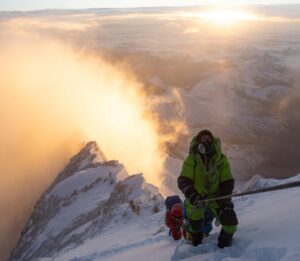Beginning this year, climbers will have to bring their poo down from Everest, using bags that will be distributed in Base Camp and checked on the way back.
Not surprisingly, this news has made headlines around the world. Reactions included the usual criticisms of millionaires polluting natural ecosystems. However, a whole new set of environmental regulations are currently under discussion, beyond waste management. Also, the biggest problem may not be on the mountain, but below Base Camp.
The new measures will hopefully be in place in time for this May. The key question, however, is whether the paperwork and the regulations will remain as good intentions or lead to better practices in the increasingly complex world of commercial expeditions and the fragile environments in which they take place.
The higher, the worse
Human excrement is not a new issue on Everest or elsewhere, but increased crowding on the mountain and oxygen-supported climbers staying longer in higher camps has aggravated the problem. By now, it has become almost unbearable.
Both foreign and local climbers have started to denounce the poor state of higher camps on Everest, especially the huge Camp 4 at 7,900m on the South Col. Here, trash of all kinds piles up on the mainly rocky, windswept terrain. Any litter is a serious problem in the long term, but human waste, in particular, poses a health threat.
All outfitters have toilet facilities in Base Camp, and nowadays, there are also toilets in Camp 2 at 6,400m.
“Last year, the Nepal army set up public toilets at Camp 2,” Dawa Steven Sherpa of Asian Trekking told ExplorersWeb. “They also…managed to bring down toilet waste in barrels from Camp 2 [for] the first time.”
The problem is higher up, along the route and in Camps 3 and 4. Traditionally, climbers relieve themselves by digging a little hole, preferably in snow. But that is difficult at high altitude, where climbers dress in several layers, are on frozen rock or ice, and are often clipped to a fixed rope. Feces don’t degrade in low temperatures and may pollute the snow, which other climbers may eventually melt for drinking water.
The damage seemed under control when few expeditions visited the huge mountains each year. But nowadays, with over 1,000 people on Everest each spring, the impact has become too great to ignore. According to the Sagarmatha Pollution Control Committee (SPCC), the spring 2023 climbing season at Everest Base Camp generated 75 tonnes of waste, including 21,507kg of human waste.
It is unclear how much human waste is left on the higher slopes. An estimate for 2019 was 7,200kg per season. Meanwhile, the number of permits for foreign climbers grows every year.
Bring it along
Mingma Sherpa of the Pasang Lhmau municipality (including most of the Khumbu Valley) told the BBC that urgent measures will be required this season because climbers are starting to get sick. The SPCC will dispose of 8,000 U.S.-made special wag bags, containing chemicals (and material similar to cat litter). It intends to give two per climber to bring up to the higher camps. Everyone will — supposedly — have to carry their bags down and present them for disposal at Base Camp. But these measures are not new.

Leave no trace? Photo taken last year at the Khumbu Icefall. Photo: Elia Saikaly
Sensitivity around glacial terrain is a common practice in mountain ranges around the world, and mandatory in places such as Aconcagua, Denali, and Antarctica. Even on Everest, some climbers use poo bags, and a few outfitters encourage their clients to use them as well.
“We’ve been using poo bags voluntarily on Everest for a long time,” Lukas Furtenbach told ExplorersWeb. “I don’t understand why others haven’t done it yet. It doesn’t significantly increase manpower or cost but has a significant impact on the mountain.”
It is yet to be seen, however, if everyone else will follow suit, and how are they going to deal with the dirty job. Furtenbach staff carries the bags for their clients, but that is a matter of resources and, in the end, money.
Key remaining questions
Clients on Everest come from all kinds of cultural backgrounds and have different perceptions about the services they pay for and how far they are willing to go in support of the environment. For example, how are expedition leaders and sherpa guides going to encourage paying clients to use and carry poo bags if they themselves are not willing to? The upper-end outfitters may assign sherpas to carry their clients’ bags, but what about the lower-priced companies? In the end, the climber chooses to collaborate or not. Unfortunately, Everest is not exactly famous for being the most collaborative place on Earth.
Moreover, the disposal and management of the bags could lead to a different kind of pollution. Tashi Sherpa of Seven Summit Treks, the biggest expedition outfitter on Everest, points to a controversial method of extraction: helicopters.
As he told Outside Magazine, he plans to ask the local government to allow his company’s helicopters to “collect the poop in a drum and then use a helicopter and a long line to fly it down to Base Camp.”
That would prevent them from having to hire extra staff to remove the waste. On the other hand, it is one more step in the overuse of helicopters on the 8,000ers. This increases, rather than decreases, pollution on the mountain.
Shitstorm further below

Solid waste at Everest Base Camp. Photo: Sagarmatha Pollution Control Committee
The final question is what happens to the ever-increasing amount of human waste from Base Camp downward. The SPCC is in charge of managing the organic waste. As they state on their website: “Currently, human waste and kitchen waste generated by expedition groups on Mt. Everest, Mt. Nuptse, and Mt. Lhotse at Everest Base Camp are being disposed in a pit near Gorakshep.”
In fact, three pits were used each year, in rotation. Recently, the thousands of kilos of human excrement were brought slightly further down, to Lobuche. But neither place is a solution since both can lead to pollution in the Khumbu Glacier basin and in the rivers flowing into villages in the Khumbu.
The SPCC claims to be in conversation with the Mt. Everest Biogas Project, which is designing an anaerobic digester aiming to produce energy from waste. But despite some press in international media, such a plant has not yet been installed. The project seems to have stalled since the website’s last update in 2018.
See more about the project (and some gross pictures of the excrement problem below Everest Base Camp) here. Unless something is done in a hurry, the real shitstorm might be not above, but below the slopes of Everest.






